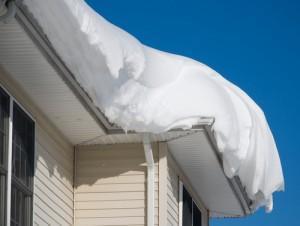
Ice dams are the leading cause of water damage and mold and mildew growth in your home. Every year they cause millions of dollars in damage. Just like the way it sounds; ice dams are a buildup of ice formed at the edge of your roof. It prevents melting snow from draining and can cause backed-up water to leak into your home’s walls, insulation, ceiling, and other areas.
How to know if you have an ice dam.
Icicles are the first sign of ice dam formation on your roof. On a well-made, properly ventilated and insulated roof, only a pile of fluffy snow will sit on the edge.
Another sign of a potential ice dam is water stains on your ceilings or walls. With resulting leaks, water can penetrate your home and cause mold or mildew growth. Any discoloration or dripping water is an immediate cause for action on your roof.
What causes ice dams?
The top cause of ice dams is an uneven roof surface temperature. This can cause snow to melt in higher, warmer areas and flow down to freeze in cooler areas. An ice dam freezes at the edge of your roof and causes the water above it on warmer surfaces to finds cracks and openings in your roof covering. Water then enters your attic space and flows into surrounding areas like your walls or ceiling insulation resulting in stains and mold or mildew growth.
Why does my roof have uneven surface temperatures?
Your roof can develop uneven surface temperatures from a variety of sources. Of these include heat from your house, heat from the sun, or a damaged roof.
Cause #1: Indoor heat
- It is VITAL to keep your attic cool. If you don’t have proper insulation or ventilation in your attic, roof surface temperatures will fluctuate. Poorly insulated areas like light fixtures, doors, or outlets can leak warm air rising into your attic causing a dysfunctional roof surface.
Cause #2: Radiant heat from the sun
- With winter temperatures varying from day to night, snow sitting on your roof can quickly melt from daytime solar heat. And then when night comes, it freezes. Mother nature’s power is unavoidable, so taking the proper steps to prevent varying roof surface temperatures will prevent further damage.
Cause #3: Damaged Roof
- This one is a no-brainer. If you have a damaged roof, broken shingles, or faulty gutters; any form of leak or ice build-up is inevitable. It’s time for a new roof!
How can I prevent an Ice Dam?
There are steps available that can protect your home and roof from ice dams and future water damage. Here are a couple of tips that can help you:
Tip #1: Scrape Snow
- The bottom 3-6 feet of your roof is the danger zone for ice dam formation. If you remove the snow sitting there, you can prevent it from melting and turning into an ice dam. This involves using a snow rake or push broom to steer snow off of the roof. Flat roofs are better suited for this type of clearing because the fall risk increases depending on the steepness of your roof. If you are uncomfortable taking on this task, a professional is always happy to help!
Tip #2: Clear Gutters and Downspouts
- Clearing your gutters and downspouts in the fall will provide melting water from the snow a place to go, preventing any ice dam formation.
Tip #3: Insulate
- Insulate your house! Keeping the interior of your house warm requires proper insulation in the attic and walls of your house. Rising warm air that travels through ceilings and improper insulation reaches the attic and warms your roof.
Tip #4: Vent the Attic
- Proper ventilation allows cool air to flow through your roof. This includes ridge ventilation at the peak of your roof, soffit ventilation, and more.
Tip #5: Install Water-repellent Membranes
- Ice and water shield is a waterproof roof underlayment membrane that is designed to protect vulnerable parts of your roof from ice and water damage. Adding this to the bottom 3-6 feet of your roof helps protect your home from water leaks due to ice dams.
Tip #6: Replace Your Roof
- It might just be time to replace your roof to ensure that your shingles, ventilation, and gutters are doing their job right! Time and weather can have a big impact on the durability of your roof, and if damage or water leaks continue to happen, now might be the time for a replacement! If fully replacing your roof isn’t in your budget, replacing the bottom 3 or 4 feet of your roof with a metal drip edge will tackle the issue in the meantime.

Getting Professional Help
If ice dams have already formed and you can’t perform the preventative measures yourself, or you want to have your home inspected for ice dam risks, contact GF Sprague. We have 45 years of experience with ice dam prevention in Massachusetts and can often take care of the problem permanently. Call us to arrange an inspection or to discuss your situation.
